Stress–Dilatancy Behavior of Highly Elastic Rubber-Added Cohesionless Materials
Abstract
1. Introduction
2. Basic Theoretical Background
3. Comparative Analysis on η–Dt and η–Dp
3.1. Negligible Elastic Deformation in the Dilatancy of Conventional Cohesionless Materials
3.2. Impact of Elastic Deformation in the Dilatancy of Highly Elastic Cohesionless Materials
4. Calibration of Dilatancy Parameters Considering Plastic
4.1. Calibration Methods for Sand
4.2. Calibration Methods for Highly Elastic Materials
4.2.1. Calibration of the Parameter m
4.2.2. Calibration of the Parameter D0
5. Validation of the Parameter Calibration Methods
6. Discussion
7. Conclusions
- (1)
- Compared to η–Dp, the η–Dt response tends to overestimate both the phase transformation stress ratio and the reduction capacity in dilatancy for highly elastic RCM. Therefore, the η–Dp response is more suitable for the dilatancy analysis of RCM.
- (2)
- The difference between Dp and Dt increases initially with increasing deviatoric strain during the stress hardening, and subsequently decreases, eventually approaching zero at the peak stress state. During stress softening, Dp and Dt start to exhibit a difference again, but relatively smaller compared to the stress hardening. In addition, with increasing confining pressure and rubber content, the difference between Dp and Dt becomes more significant.
- (3)
- The dilatancy parameters D0 and m, calibrated by the modified method in this paper, can more precisely capture the strength–dilatancy behavior of highly elastic materials under different initial confining stresses and rubber contents.
Author Contributions
Funding
Institutional Review Board Statement
Informed Consent Statement
Data Availability Statement
Conflicts of Interest
References
- Bosscher, P.J.; Edil, T.B.; Kuraoka, S. Design of highway embankments using tire chips. J. Geotech. Geoenviron. Eng. 1997, 123, 295–304. [Google Scholar] [CrossRef]
- Yoon, S.; Prezzi, M.; Siddiki, N.Z.; Kim, B. Construction of a test embankment using a sand–tire shred mixture as fill material. Waste Manag. 2006, 26, 1033–1044. [Google Scholar] [CrossRef]
- Tandon, V.; Velazco, D.A.; Nazarian, S.; Picornell, M. Performance monitoring of embankments containing tire chips: Case study. J. Perform. Constr. Facil 2007, 21, 207–214. [Google Scholar] [CrossRef]
- Lee, J.; Salgado, R.; Bernal, A.; Lovell, C. Shredded tires and rubber-sand as lightweight backfill. J. Geotech. Geoenviron. Eng. 1999, 125, 132–141. [Google Scholar] [CrossRef]
- Ma, Y.; Ma, X.; Luan, Y.; Jiang, S.; Zhang, J. Research on key influencing factors of scrap tire-soil retaining wall. Case Stud. Constr. Mater. 2023, 19, e02277. [Google Scholar] [CrossRef]
- Tsang, H.H. Seismic isolation by rubber–soil mixtures for developing countries. Earthq. Eng. Struct. Dyn. 2008, 37, 283–303. [Google Scholar] [CrossRef]
- Wu, M.; Tian, W.; He, J.; Liu, F.; Yang, J. Seismic isolation effect of rubber-sand mixture cushion under different site classes based on a simplified analysis model. Soil Dyn. Earthq. Eng. 2023, 166, 107738. [Google Scholar] [CrossRef]
- Tafreshi, S.M.; Amiri, A.; Dawson, A. Sustainable use of End-of-Life-Tires (ELTs) in a vibration isolation system. Constr. Build. Mater. 2023, 405, 133316. [Google Scholar] [CrossRef]
- Liu, F.; Wang, J.; Zhou, B.; Wu, M.; He, J.; Bin, J. Shaking table study on rubber-sand mixture cored composite block as low-cost isolation bearing for rural houses. J. Build. Eng. 2023, 76, 107413. [Google Scholar] [CrossRef]
- Zhou, E.; Yao, Y.; Cui, L.; Wang, L.; Zuo, X. Dynamic properties of silty sand mixed with rubber particles for medium strain. Int. J. Civ. Eng. 2023, 21, 1867–1878. [Google Scholar] [CrossRef]
- Zhou, E.; Bai, Y.; Zuo, X. Evaluation of dynamic behaviour of rubber particle-clay mixtures using the skeleton void ratio approach. Constr. Build. Mater. 2024, 426, 136127. [Google Scholar] [CrossRef]
- Zhou, E.; Wang, Q. Experimental Investigation on Shear Strength and Liquefaction Potential of Rubber-Sand Mixtures. Adv. Civ. Eng. 2019, 2019, 5934961. [Google Scholar]
- Warith, M.; Evgin, E.; Benson, P. Suitability of shredded tires for use in landfill leachate collection systems. Waste Manag. 2004, 24, 967–979. [Google Scholar] [CrossRef]
- Kaushik, M.; Kumar, A.; Bansal, A. Performance assessment of tire chips–gravel mixes as leachate drainage layer material. Int. J. Geotech. Eng. 2015, 9, 453–470. [Google Scholar] [CrossRef]
- Adesokan, D.; Fleming, I.; Hammerlindl, A. One-dimensional (1D) immediate compression and creep in large particle-sized tire-derived aggregate (TDA) for leachate collection and removal systems (LCRSs). Can. Geotech. J. 2021, 58, 982–994. [Google Scholar] [CrossRef]
- Qi, Y.J.; Indraratna, B.; Vinod, J.S. Behavior of Steel Furnace Slag, Coal Wash, and Rubber Crumb Mixtures with Special Relevance to Stress-Dilatancy Relation. J. Mater. Civ. Eng. 2018, 30, 04018276. [Google Scholar] [CrossRef]
- Qi, Y.J.; Indraratna, B.; Coop, M.R. Predicted Behavior of Saturated Granular Waste Blended with Rubber Crumbs. Int. J. Geomech. 2019, 19, 04019079. [Google Scholar] [CrossRef]
- Indraratna, B.; Malisetty, R.S.; Arachchige, C.; Qi, Y.; Rujikiatkamjorn, C. Sustainable Performance of Recycled Rubber and Mining Waste Utilized for Efficient Rail Infrastructure. Indian Geotech. J. 2024, 54, 1738–1750. [Google Scholar] [CrossRef]
- Disfani, M.M.; Tsang, H.-H.; Arulrajah, A.; Yaghoubi, E. Shear and compression characteristics of recycled glass-tire mixtures. J. Mater. Civ. Eng. 2017, 29, 06017003. [Google Scholar] [CrossRef]
- Phan, T.M.; Ma, H.-J.; Park, D.-W. Evaluation on performance of rubber tire powder and waste glass modified binder as crack filling materials using 3D printing technology. Constr. Build. Mater. 2024, 416, 135225. [Google Scholar] [CrossRef]
- Gerges, N.; Issa, C.A.; Antoun, M.; Sleiman, E.; Hallal, F.; Shamoun, P.; Hayek, J. Eco-friendly mortar: Optimum combination of wood ash, crumb rubber, and fine crushed glass. Case Stud. Constr. Mater. 2021, 15, e00588. [Google Scholar] [CrossRef]
- Yao, T.; Han, X.; Li, B.; Guo, F.; Ji, H.; Ai, C.; Han, S. Development of polyurethane urea (PUU)-waste rubber particles (WRP) composite materials for active ice-breaking of groove-filled asphalt pavement. Case Stud. Constr. Mater. 2024, 21, e03617. [Google Scholar] [CrossRef]
- Tasalloti, A.; Chiaro, G.; Murali, A.; Banasiak, L. Physical and mechanical properties of granulated rubber mixed with granular soils—a literature review. Sustainability 2021, 13, 4309. [Google Scholar] [CrossRef]
- Li, X.S.; Dafalias, Y.F. Dilatancy for cohesionless soils. Géotechnique 2000, 50, 449–460. [Google Scholar] [CrossRef]
- Rowe, P.W. The stress-dilatancy relation for static equilibrium of an assembly of particles in contact. Proc. R. Soc. London Ser. A Math. Phys. Sci. 1962, 269, 500–527. [Google Scholar] [CrossRef]
- Chiu, C.; Ng, C.W.W. A state-dependent elasto-plastic model for saturated and unsaturated soils. Géotechnique 2003, 53, 809–829. [Google Scholar] [CrossRef]
- Nova, R.; Wood, D.M. A constitutive model for sand in triaxial compression. Int. J. Numer. Anal. Methods Geomech. 1979, 3, 255–278. [Google Scholar] [CrossRef]
- Wood, D.M. Soil Behaviour and Critical State Soil Mechanics; Cambridge University Press: Cambridge, UK, 1990. [Google Scholar]
- Zhang, H.; Zhang, X. A state-dependent dilatancy model for cemented sand. Comput. Geotech. 2024, 173, 106527. [Google Scholar] [CrossRef]
- Singh, S.; Kandasami, R.K.; Murthy, T.G.; Coop, M.R. On the modelling of stress-dilatancy behavior in weakly cemented sands. Soils Found. 2023, 63, 101328. [Google Scholar] [CrossRef]
- Taiebat, M.; Dafalias, Y.F. SANISAND: Simple anisotropic sand plasticity model. Int. J. Numer. Anal. Methods Geomech. 2008, 32, 915–948. [Google Scholar] [CrossRef]
- Yu, H.; Shen, X.-m.; Ye, Y.-c.; Yang, J.; Zhu, C.-h. Large-scale triaxial tests on dilatancy characteristics of lean cemented sand and gravel. Front. Earth Sci. 2021, 9, 799215. [Google Scholar] [CrossRef]
- Been, K.; Jefferies, M. Stress-dilatancy in very loose sand. Can. Geotech. J. 2004, 41, 972–989. [Google Scholar] [CrossRef]
- Szypcio, Z. Stress-dilatancy for soils. Part I: The frictional state theory. Stud. Geotech. Et Mech. 2016, 38, 51–57. [Google Scholar] [CrossRef]
- Jefferies, M. On the fundamental nature of the state parameter. Géotechnique 2022, 72, 1082–1091. [Google Scholar] [CrossRef]
- Youwai, S.; Bergado, D.T. Strength and deformation characteristics of shredded rubber tire sand mixtures. Can. Geotech. J. 2003, 40, 254–264. [Google Scholar] [CrossRef]
- Mashiri, M.S. Monotonic and cyclic behaviour of sand-tyre chip (STCh) mixtures. Ph.D. Thesis, University of Wollongong, Wollongong, NSW, Australia, 2014. [Google Scholar]
- Mashiri, M.; Vinod, J.; Sheikh, M.N.; Tsang, H.-H. Shear strength and dilatancy behaviour of sand–tyre chip mixtures. Soils Found. 2015, 55, 517–528. [Google Scholar] [CrossRef]
- Mashiri, M.S.; Vinod, J.S.; Sheikh, M.N. Constitutive Model for Sand-Tire Chip Mixture. Int. J. Geomech. 2016, 16, 04015022. [Google Scholar] [CrossRef]
- Rouhanifar, S.; Afrazi, M.; Fakhimi, A.; Yazdani, M. Strength and deformation behaviour of sand-rubber mixture. Int. J. Geotech. Eng. 2021, 15, 1078–1092. [Google Scholar] [CrossRef]
- Noorzad, R.; Raveshi, M. Mechanical behavior of waste tire crumbs–sand mixtures determined by triaxial tests. Geotech. Geol. Eng. 2017, 35, 1793–1802. [Google Scholar] [CrossRef]
- Tawk, M.; Indraratna, B. Role of rubber crumbs on the stress-strain response of a coal wash matrix. J. Mater. Civ. Eng. 2021, 33, 04020480. [Google Scholar] [CrossRef]
- Arachchige, C.M.K. Experimental and Numerical Study of Rubber Intermixed Ballast System Subjected to Monotonic and Cyclic Loading. Ph.D. Thesis, University of Technology Sydney (Australia), Sydney, Australia, 2022. [Google Scholar]
- Zhang, J.-Q.; Wang, X.; Yin, Z.-Y. DEM-based study on the mechanical behaviors of sand-rubber mixture in critical state. Constr. Build. Mater. 2023, 370, 130603. [Google Scholar] [CrossRef]
- Szypcio, Z.; Dolzyk-Szypcio, K.; Nurgaliyev, A. Stress-dilatancy relationship of sand-rubber mixtures. IOP Conf. Ser. Mater. Sci. Eng. 2022, 1260, 012003. [Google Scholar] [CrossRef]
- Anastasiadis, A.; Senetakis, K.; Pitilakis, K. Small-strain shear modulus and damping ratio of sand-rubber and gravel-rubber mixtures. Geotech. Geol. Eng. 2012, 30, 363–382. [Google Scholar] [CrossRef]
- Lee, J.-S.; Dodds, J.; Santamarina, J.C. Behavior of rigid-soft particle mixtures. J. Mater. Civ. Eng. 2007, 19, 179–184. [Google Scholar] [CrossRef]
- Fu, R.; Yang, B.; Hu, X.; Zhou, B.; Coop, M.R. A micromechanical investigation of sand–rubber mixtures using the discrete element method. Eng. Geol. 2023, 318, 107106. [Google Scholar] [CrossRef]
- Zornberg, J.G.; Cabral, A.R.; Viratjandr, C. Behaviour of tire shred sand mixtures. Can. Geotech. J. 2004, 41, 227–241. [Google Scholar] [CrossRef]
- Bali Reddy, S.; Pradeep Kumar, D.; Murali Krishna, A. Evaluation of the optimum mixing ratio of a sand-tire chips mixture for geoengineering applications. J. Mater. Civ. Eng. 2016, 28, 06015007. [Google Scholar] [CrossRef]
- Hataf, N.; Rahimi, M. Experimental investigation of bearing capacity of sand reinforced with randomly distributed tire shreds. Constr. Build. Mater. 2006, 20, 910–916. [Google Scholar] [CrossRef]
- Richart, F.E.; Hall, J.R.; Woods, R.D. Vibrations of Soils and Foundations; Prentice-Hall: Hoboken, NJ, USA, 1970. [Google Scholar]
- Beer, F.P.; Johnston, E.R.; DeWolf, J.T.; Mazurek, D.F.; Sanghi, S. Mechanics of Materials; Mcgraw-Hill New York: New York, NY, USA, 1992; Volume 1. [Google Scholar]
- Ishihara, K. Soil Behaviour in Earthquake Geotechnics; Oxford University Press: Oxford, UK, 1996. [Google Scholar]
- Been, K.; Jefferies, M.G.; Hachey, J. The critical state of sands. Geotechnique 1991, 41, 365–381. [Google Scholar] [CrossRef]
- Wagner, A.C.; de Sousa Silva, J.P.; de Azambuja Carvalho, J.V.; Rissoli, A.L.C.; Cacciari, P.P.; Chaves, H.M.; Scheuermann Filho, H.C.; Consoli, N.C. Mechanical behavior of iron ore tailings under standard compression and extension triaxial stress paths. J. Rock Mech. Geotech. Eng. 2023, 15, 1883–1894. [Google Scholar] [CrossRef]
- Ferreira, P.; Bica, A. Problems in identifying the effects of structure and critical state in a soil with a transitional behaviour. Géotechnique 2006, 56, 445–454. [Google Scholar] [CrossRef]
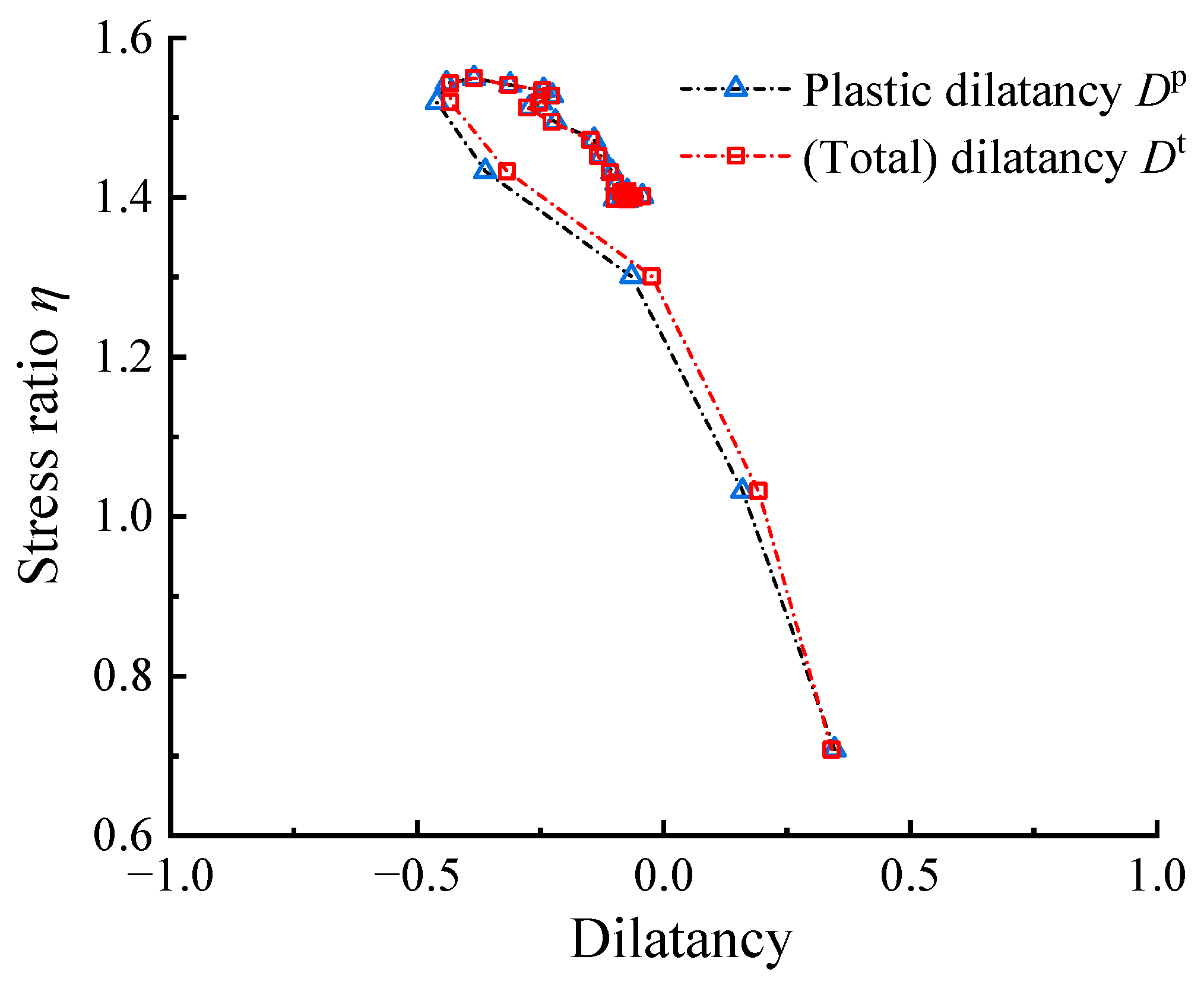
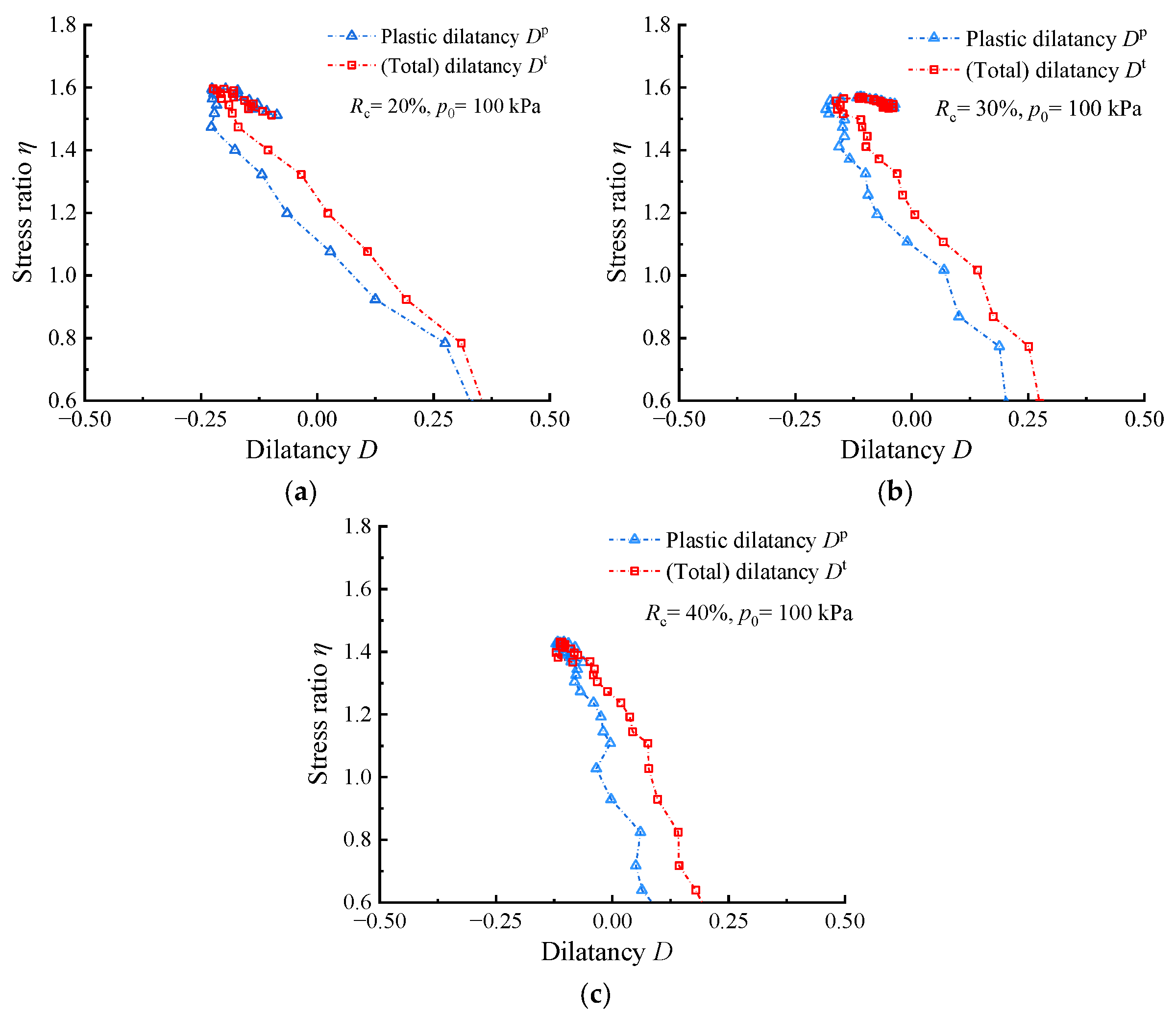

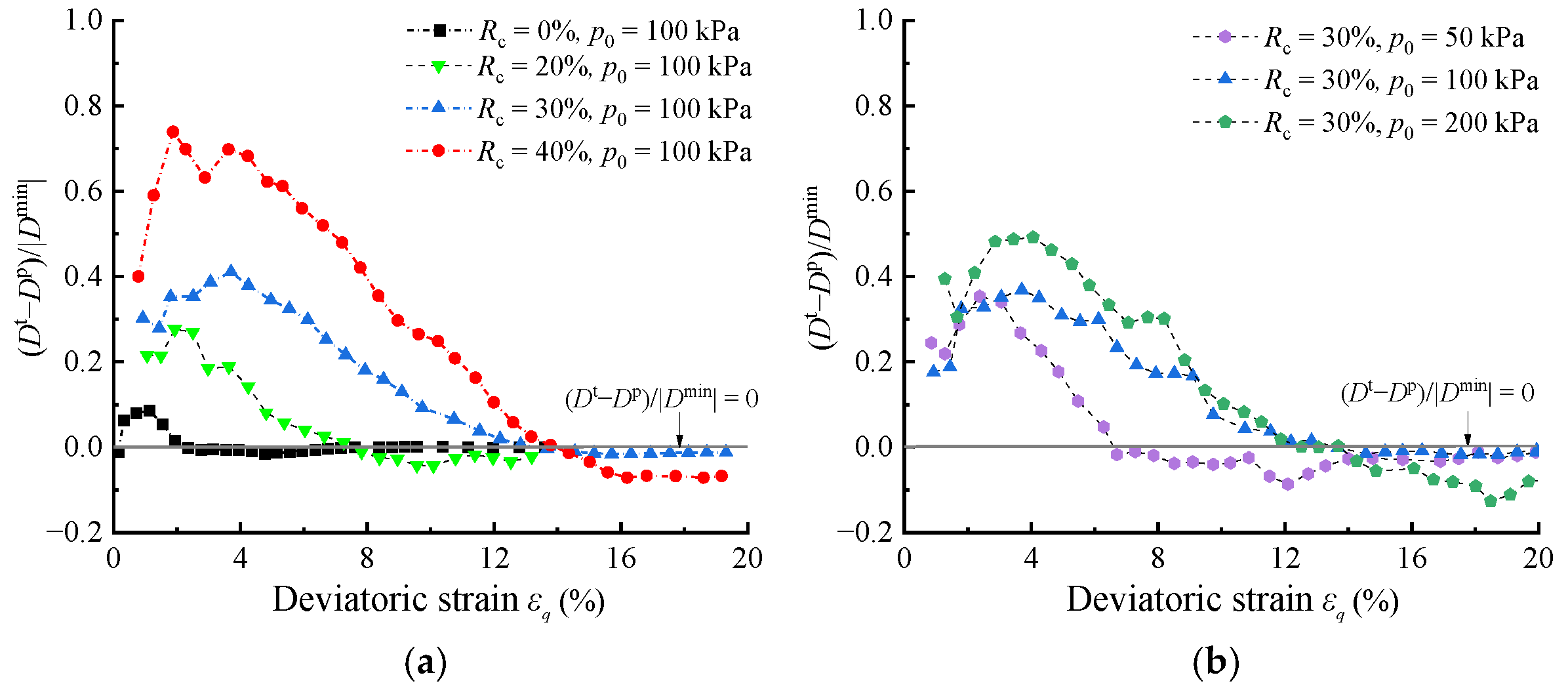
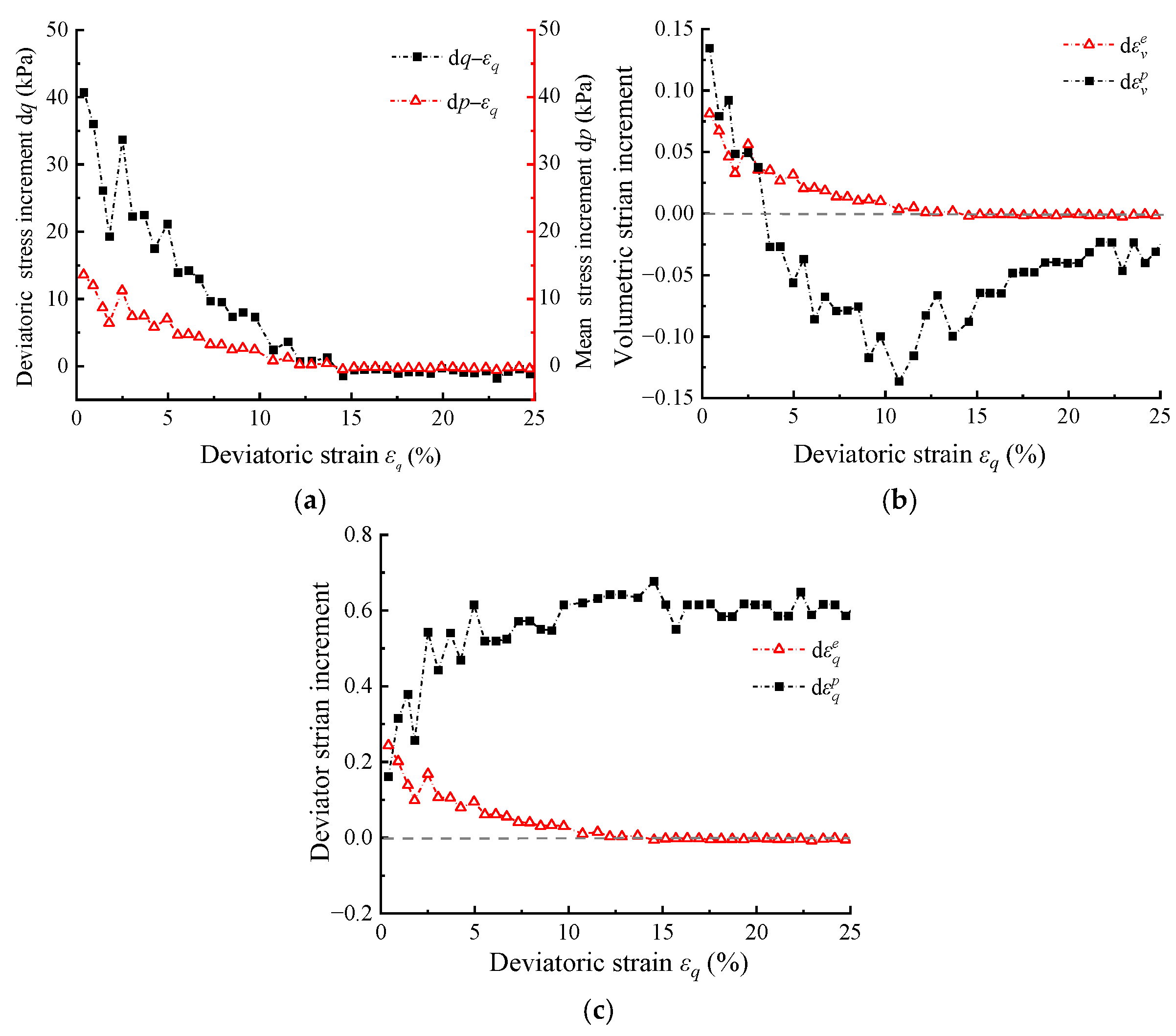
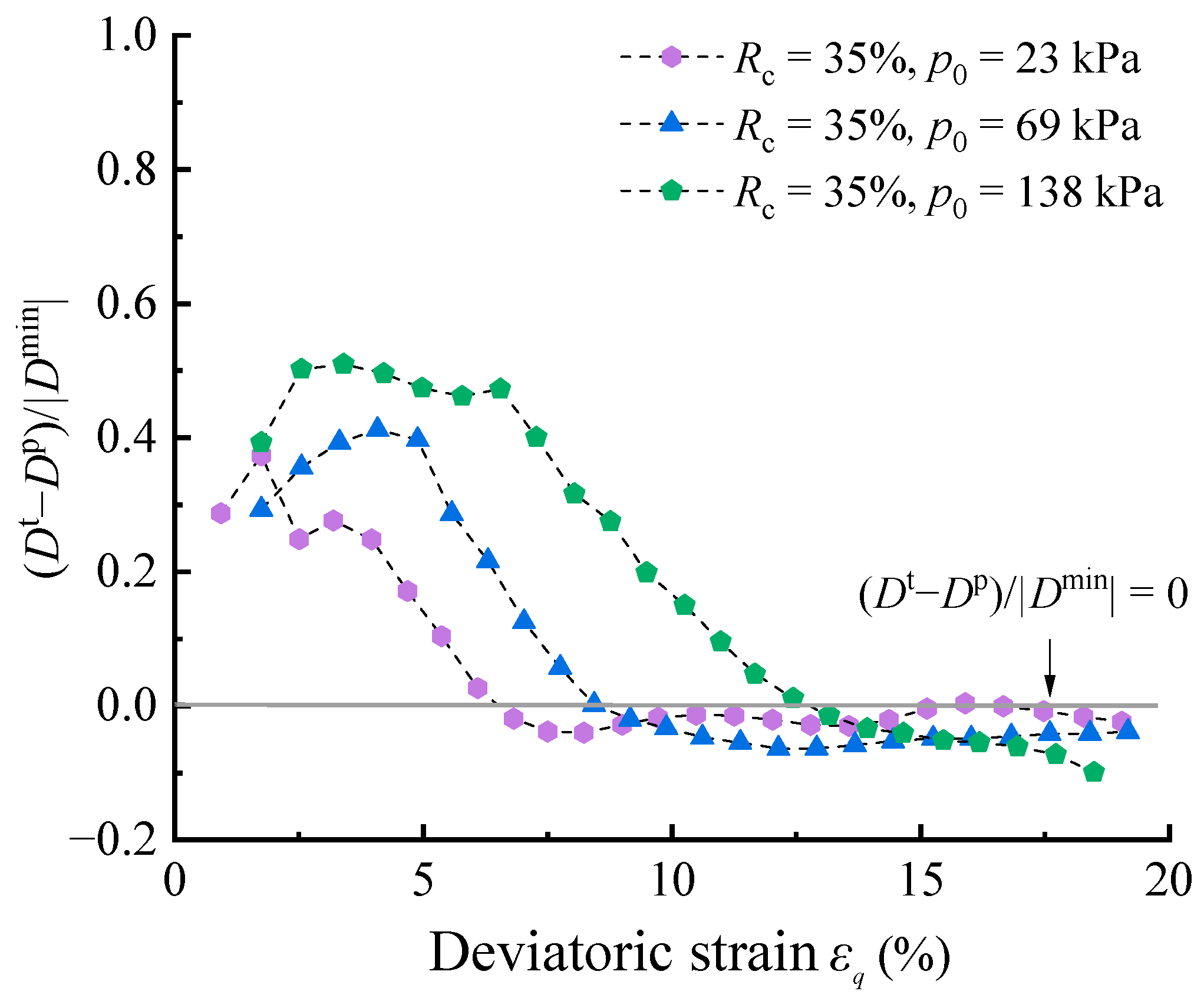
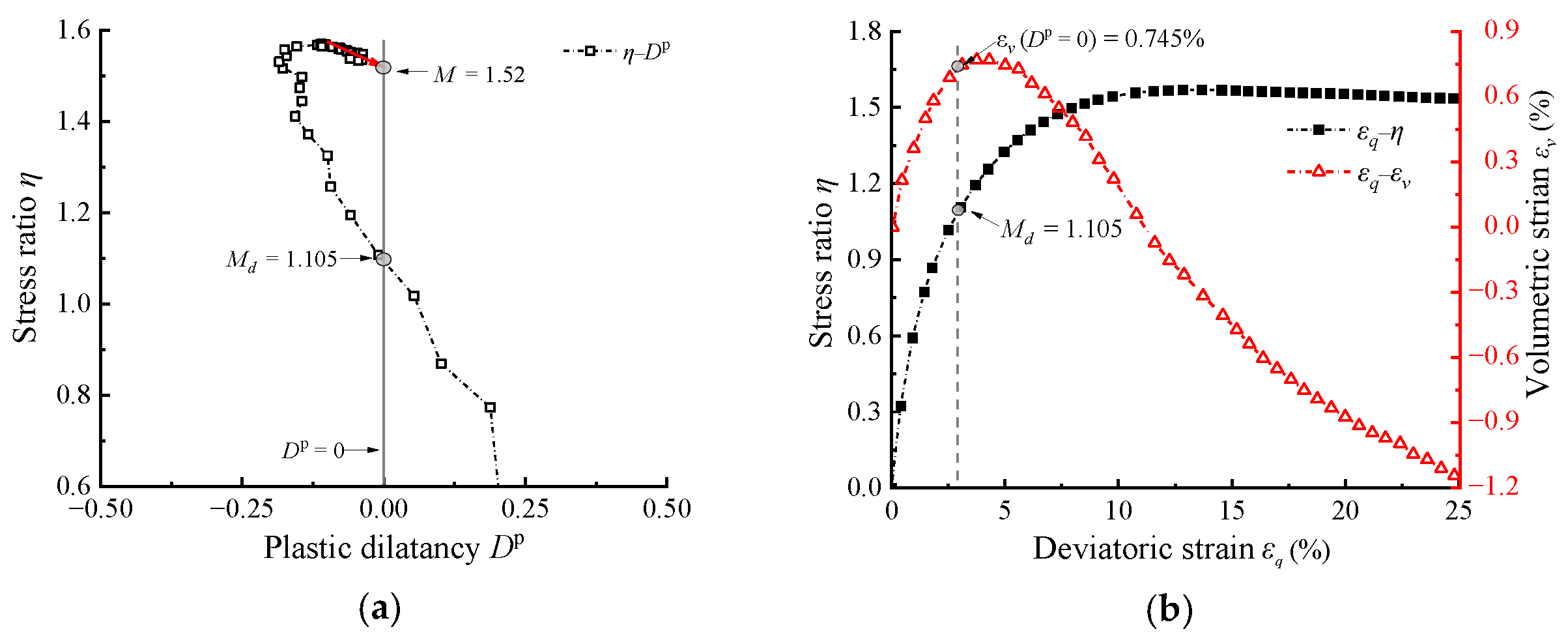


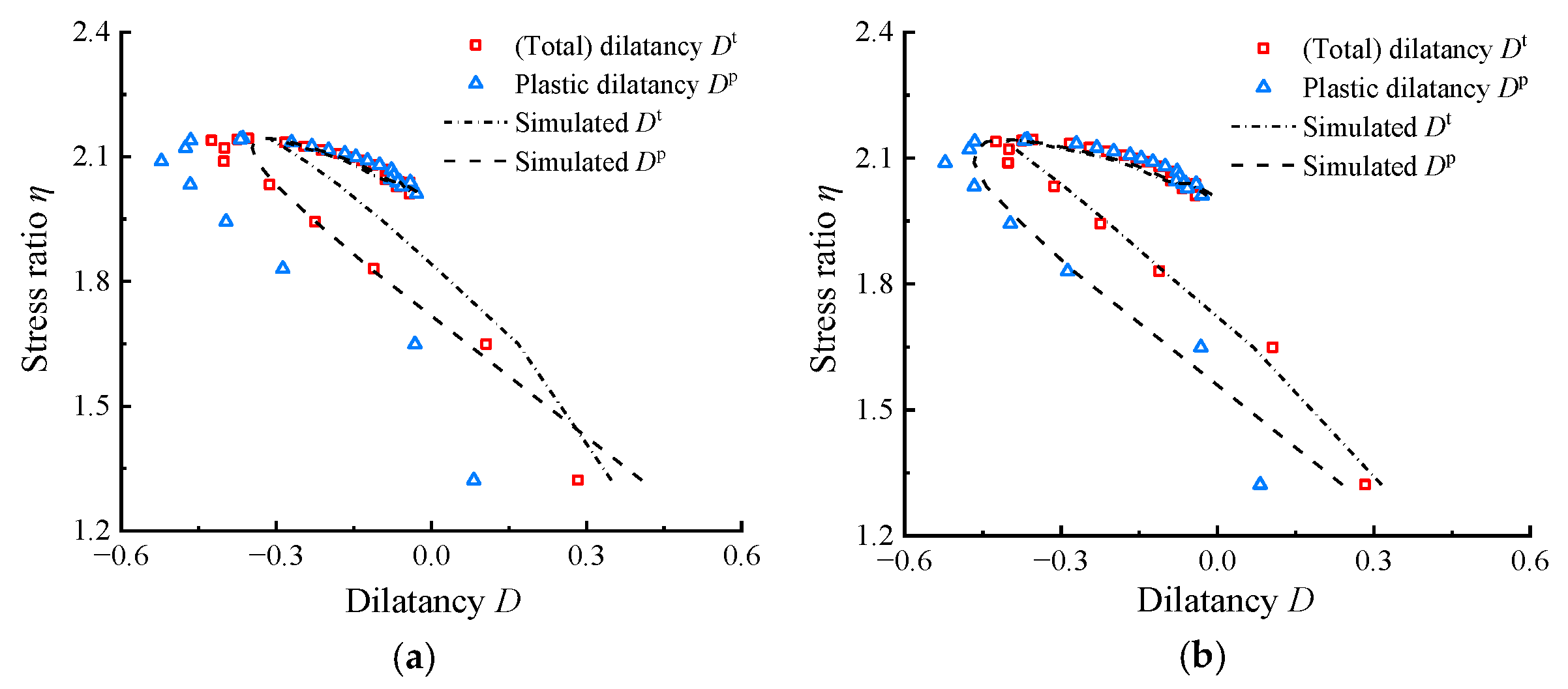
| Data Source | Rc (%) | p0 (kPa) | e0 | G0 | v |
|---|---|---|---|---|---|
| Youwai and Bergado [36] | 20% | 100 | 0.36 | 18 | 0.33 |
| 30% | 100 | 0.29 | 10 | 0.33 | |
| 40% | 100 | 0.30 | 6 | 0.33 | |
| Mashiri et al. [37,38] | 35% | 23 | 0.352 | 10 | 0.33 |
| 35% | 69 | 0.347 | 7 | 0.37 | |
| 35% | 138 | 0.339 | 5 | 0.4 |
| Data Source | Rc (%) | p0 (kPa) | e0 | M | eΓ | λ | m | D0 |
|---|---|---|---|---|---|---|---|---|
| Youwai and Bergado [36] | 20% | 100 | 0.36 | 1.45 | 0.44 | 0.0102 | 8 | 1.1 |
| 30% | 100 | 0.29 | 1.45 | 0.53 | 0.0302 | 4 | 0.8 | |
| 40% | 100 | 0.30 | 1.45 | 0.66 | 0.0302 | 1.5 | 0.4 | |
| Mashiri et al. [37,38] | 35% | 23 | 0.352 | 1.97 | 0.432 | 0.01 | 5 | 2.1 |
| 35% | 69 | 0.347 | 1.72 | 0.432 | 0.01 | 9 | 1.2 | |
| 35% | 138 | 0.339 | 1.61 | 0.432 | 0.01 | 9.8 | 1.05 |
Disclaimer/Publisher’s Note: The statements, opinions and data contained in all publications are solely those of the individual author(s) and contributor(s) and not of MDPI and/or the editor(s). MDPI and/or the editor(s) disclaim responsibility for any injury to people or property resulting from any ideas, methods, instructions or products referred to in the content. |
© 2024 by the authors. Licensee MDPI, Basel, Switzerland. This article is an open access article distributed under the terms and conditions of the Creative Commons Attribution (CC BY) license (https://creativecommons.org/licenses/by/4.0/).
Share and Cite
Zhang, H.; Zhang, X.; Li, L.; Jiang, Z. Stress–Dilatancy Behavior of Highly Elastic Rubber-Added Cohesionless Materials. Materials 2024, 17, 5264. https://doi.org/10.3390/ma17215264
Zhang H, Zhang X, Li L, Jiang Z. Stress–Dilatancy Behavior of Highly Elastic Rubber-Added Cohesionless Materials. Materials. 2024; 17(21):5264. https://doi.org/10.3390/ma17215264
Chicago/Turabian StyleZhang, Haifeng, Xinrui Zhang, Linjie Li, and Zihua Jiang. 2024. "Stress–Dilatancy Behavior of Highly Elastic Rubber-Added Cohesionless Materials" Materials 17, no. 21: 5264. https://doi.org/10.3390/ma17215264
APA StyleZhang, H., Zhang, X., Li, L., & Jiang, Z. (2024). Stress–Dilatancy Behavior of Highly Elastic Rubber-Added Cohesionless Materials. Materials, 17(21), 5264. https://doi.org/10.3390/ma17215264






